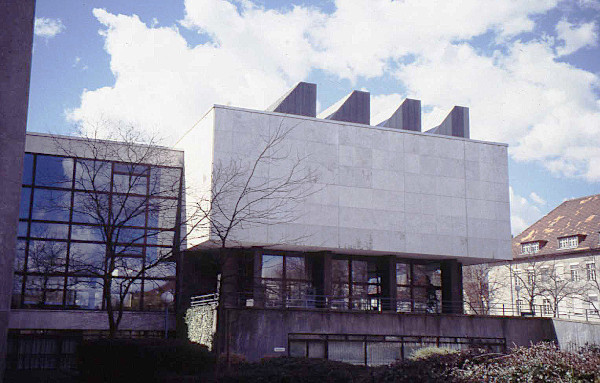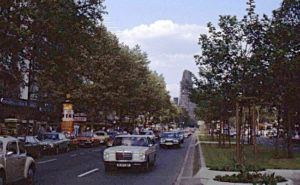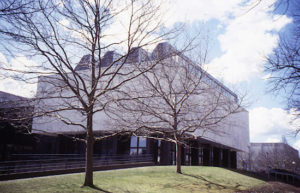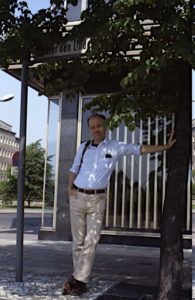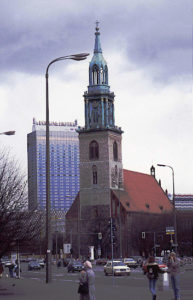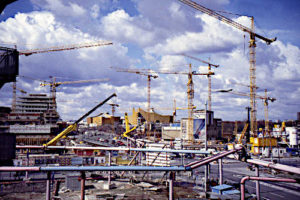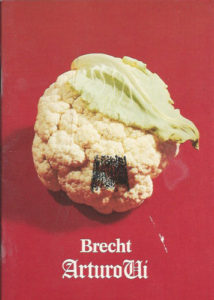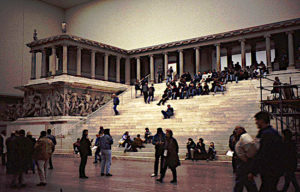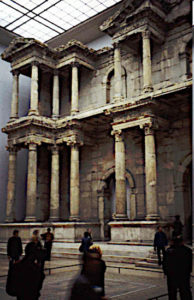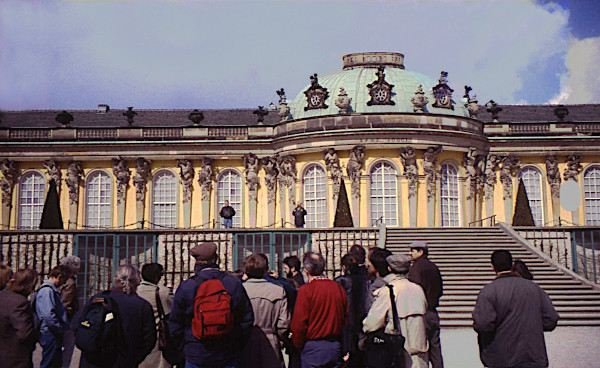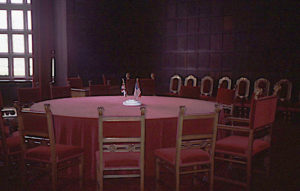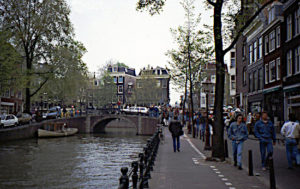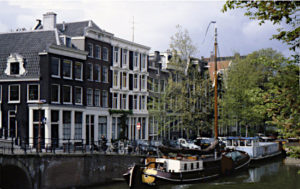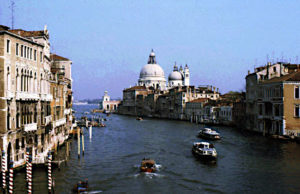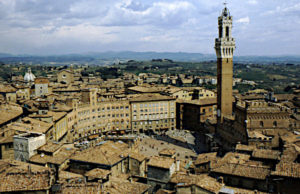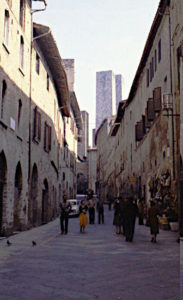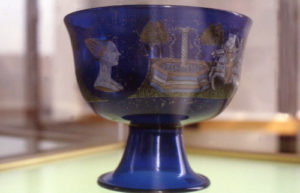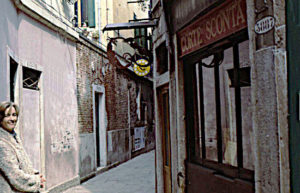Chapter 30 (Part 2): Travels from Paris — Berlin and more
In 1983 we more or less on a fluke decided to go to Berlin and get a one-day visa for East Berlin. We had worked on improving our German ever since we had started going to the Austrian Alps for mountain hiking and climbing in the summer. We had both read novels and plays by Dürrenmatt, a novel by Max Frisch and one novel by Alfred Andersch. it seems like a strange coincidence that all these three writers should be Swiss, or at least lived in Switzerland. Andersch is German by birth.
I think much vocabulary came back to us, but it was not always the kind of vocabulary you use in everyday speaking. I had seven years of German in secondary school, but my speaking had never been one of my strong points. The way we were taught German did not prepare us for speaking. My knowledge of grammar was good enough though and making sentences with all the strange German verbs at the end of the sentence was easy for me too.
In West Berlin English was understood and spoken, but in East Berlin speaking German was a necessity — in fact, the only way to communicate.
In West Berlin, the only ruin from the war was the Kaiser Wilhelm Memorial Church (die Kaiser-Wilhelm-Gedächtnis-Kirche), which had been left to remind later generations of the horrors and destruction of World War II, which, as we know well, the Germans themselves started, with considerable support from Austria.
On the bus-ride down south to the Dahlem Ethnological Museum, which first opened in 1973, we traveled past long rows of drab apartment buildings, where it could easily be seen how the city government had been in a great hurry, when the war was over, to remove all traces of ruined buildings and to replace the ruins by new apartment buildings and, even though certainly comfortable, remarkably unaesthetic buildings. No pleasant architecture had been considered when all these hundreds and hundreds of drab buildings mushroomed up. I can well imagine that the goal had been to create decent housing for thousands of homeless families, and very understandably and commendably so.
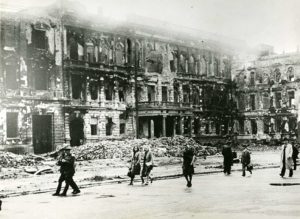
Berlin after Worls War II Source National WW II Museum
The bombing of Berlin by the Allies — the U.S, the U.K., and the last year, even France, had been ferocious. Now, after the end of the war, the survivors, the thousands of people returning to Berlin had to be housed and be helped to find a way to go on with their lives. That must not have been easy, and I can well imagine why there was all this haste to provide decent housing.[1. “It was bombed by the RAF Bomber Command between 1940 and 1945, by the USAAF Eighth Air Force between 1943 and 1945, and the French Air Force between 1944 and 1945” Bombing of Berlin in World War II]
“According to statistics composed by the Polish ministry of defense, military sappers intervene on average 7 to 8 thousand times a year, and dispose of about 400 thousand (yes, thousand) ‘explosive and hazardous items’, most of which are unexploded ordnance from WW2.”[2. How did they clean up all the battle debris?]
Back to the magnificent Dahlem Museum. It was almost beyond belief to see the affluent villas set inside beautiful yards, which surrounded the Dahlem Museum and which had clearly been left intact by the ferocious bombing of Berlin in the war. Was there really even one individual who had not really suffered from the horrors of that cruel war?
The Dahlem Museum comprises outstanding art and artifacts that were created outside Europe, goods that were brought to Berlin in the 19th and 20th centuries.
Strangely enough, we apparently did not take any pictures of this gorgeous and very modern building and its striking architecture. It had been planned originally in 1914, but two wars got in the way for ethnological museum building. It was brought back as a project in the late sixties and was finished in 1973.
I went back to Dahlem Museum in 1997 when John was at an international meeting with computer people. That is when I took the pictures I now have.
“Archaeological artifacts featured in the exhibition ‘American Archaeology’ – ranging from painted pottery to stone figures of gods and exquisite gold objects – date from as far back as 2000 BCE and demonstrate the rich cultural heritage of pre-Spanish cultures in Central and South America. A particular attraction is the presentation of the South Seas collection. True-to-scale exhibits of boats and spectacular houses typical of Oceania recreate the atmosphere of the Pacific islands.” Ethnological Museum
ngg_shortcode_0_placeholder” order_by=”sortorder” order_direction=”ASC” returns=”included” maximum_entity_count=”500″]
Our day in East Berlin was living history. Starting out, of course, at Checkpoint Charlie, we made our way up to Brandenburger Tor. From there we followed the magnificent boulevard “Unter den Linden” over east to the cultural center, with the most memorable buildings from centuries past. Surprisingly enough the major pre-war cultural buildings are still standing, but they were, at this time, black with soot from all the fires during the war.
The old opera building was so black from soot, we assumed, from the fires during the vicious bombing by the Allies during the war that it was covered in scaffolding and tarpaulins. We didn’t even take a picture. There was nothing to see.
Across from it was Humboldt University, not too black though. Might they actually have cleaned it? Next to the Opera, across what was once named Kaiser-Franz-Joseph-Platz, formerly colloquially “Opernplatz“, the palace was once the home to the Kaiser when he left Sans-Souci for Berlin. The Changing of Guards took place at this palace and after watching videos I see that it took place in the very same way by the Nazis in 1936 as by the East German government in the summer of 1989, just before the wall came down.
Kaiser Wilhelm is said to usually appear at a window of the palace to watch the changing of the guards. [4. Altes Palais– The Altes Palais was once the city residence of the Kings of Prussia and the German Emperors. Wilhelm I used to appear at the window for the changing of the guard, which attracted onlookers and was even mentioned in travel guides of the time. The building now belongs to Berlin’s Humboldt University as part of its Faculty of Law. Bebelplatz]
Since then far more gruesome events have taken place at Bebelplatz. This was where the first book burning took place, and there is a plaque that says that on May 10, 1933 the first book burning took place by National Socialist students at Bebelplatz. A reminder from the USSR of the atrocities that took place during the Nazi era.
There is also a Changing of the Guards that takes place at “Die neue Wache” — “Mahnmal für die Opfer des Faschismus und Militarismus neu gestaltet” (Memorial to the victims of fascism and militarism, redesigned.) This is a memorial to remind later generations of the evils of war and dictatorship. The building dates from 1816, but since 1931 it has served as a war memorial. However, the texts on the walls inside the building seem rather to oppose the Nazi spirit than confirm it.
I remember vividly lunch in a drab restaurant, where, like in Prague a few years later, there was basically just a dish of some non-defined meat and dumplings to be had. I had it twice since I didn’t feel like filling myself up with dumplings. The waiter (Was there more than one?) was standing with his back against the wall right next to us, but he was not the least bit interested in serving us, so the meal took a while. Again, it was very much the same in Prague in 1989, just a year before Czechoslovakia had free elections in 1990.
The Forum Hotel at Alexanderplatz, the ugliest building in 1983, probably made to look a lot better since the wall came down in 1989 and the City government seriously started in on the work of cleaning up and beautifying East Berlin. Alexanderplatz no more looks anything like the grim and cold Platz it was in 1983, with this horror of a skyscraper hotel dominating it and no other really outstanding buildings.
In 1997, on our second visit to Berlin, Alexanderplatz was a hangout for dubious-looking skinheads and punks. On our way back from that Plaza on a somewhat late evening, I remember walking straight through one of those groups of really weird-looking fellows. It didn’t bother me much. But that was 14 years later. And also the skyscraper that we had found so monstrous had now become “Park Inn by Radisson Berlin”. I can try to imagine the interior metamorphosis that must have taken place at that hotel.
In 1983, on our way back from Alexanderplatz via Leipziger Street we went by Potsdamerplatz — or rather the site where the Potsdamerplatz had once been. There was nothing left of the buildings that had been savagely bombed during the war, and the only thing we could see was a poster with pictures of Potsdamerplatz from four different years. Stretching north from the one-time Platz was a huge, sad area with nothing in it. This deserted area was going to be filled with construction the next time we were in Berlin, in 1997.
Somewhere at the northeastern end of this empty area was the place where Hitler’s bunker had once been, where he killed his mistress and newly wedded wife, Eva Braun, and then himself on April 30, 1945. He married his long-time mistress just two days before the suicide. This madman had finally understood, the way his generals had seen it for many months, if not years, that the war was ultimately lost. It had been clear to the world ever since 1943.
The German defeat in Stalingrad in early 1943 had been a definitive turning point in the war. The west front was lost, mostly due to the U.S. joining the war, Africa was lost and the submarine war as well. Only a madman like Hitler could possibly order continued battles that were going to cost yet more lives — thousands of German as well as allied lives. German cities were cruelly bombed and almost annihilated because of Hitler’s insanity.
This quarter is today, in 2018, the most modern one in Berlin, I believe it is safe to say, with magnificent high-rise buildings, certainly mostly business buildings, banks, insurance companies and that kind. Some of which are not even quite finished even today, 18 years after the reunification of Germany in 1990.
One day we found that the Renaissance-Theater was playing Bertolt Brecht’s “Arthur Ui”. A 1941 play by Brecht seemed like just the right thing to see in Berlin. We went to a bookstore and bought two copies of the play, one in German and one in English. We had one day to read it. John was generous and chose the version in German and I was happy to read it in English, since I don’t read as fast as John does.
It was a hilarious day. As I remember now, decades later, we practically walked around Berlin, reading as we were walking — which is probably a distorted memory
However, we did manage to get through the play so we knew beforehand what it was going to be about — “The Resistible Rise of Arturo Ui” (Der aufhaltsame Aufstieg des Arturo Ui)
It was about the way Hitler was taught how to behave, to speak, to look in order to be impressive and sway the masses to hysterical ovations by his simple appearance and his way of holding himself like an over-lord, majestic, convincing and self-assured. The rolled r that he affected was simply a gimmick, thought of by his trainers.
I believe that Brecht’s point in writing this play was to show how politics is theater, and especially that Hitler’s appearances were nothing but that. He makes his play a parable of the Cauliflower (Blumenkohl) mafia that is trying to take over the entire business, but it is of course clear what Brecht is really referring to. “Die Blumenkohl Mafia”. Hitler is a gangster. And, above all, the happenings in the Nazi era are far from unique. They will be repeated indefinitely, as long as there is business in the world.
ngg_shortcode_1_placeholder” order_by=”sortorder” order_direction=”ASC” returns=”included” maximum_entity_count=”500″]
We saw the same play in 1996 in Lyon, mise en scène Heiner Müller. This was a Berliner Ensemble production that toured Europe. It was set up with French translations over the stage, which seemed to us a bit far reached and not really possible to profit from. But most importantly was that we did not appreciate the mise en scène at all as much as in Berlin in 1983.
_________________
We happened to get back to Berlin in 1997 because of an international meeting for computer people, which I already mentioned. John went to the meeting and I joined him a couple of days later. The city had changed enormously.
It was late winter or very early spring and on my first day in the city it started to snow. It was pretty darn cold and we had to go to a department store and stock up on woolens, scarves, gloves, and the like. It might well have been Kaufhaus Karstadt. I know I was only wearing a trench-coat, even though a warm one, so we were definitely not dressed for snow and cold winds.
This visit was mostly memorable for two things, der Museuminsel (the Museum Island) on the Spree river and the Nikolaiviertel (Nikolai Quarter) which is in old East Berlin, but we had missed it completely in 1983. It is said to have been the only part of East Berlin that the Communist regime kept attractive and in good shape. This delightful quarter right on the Spree and across from the Museum Island became our perfect dining place at least a couple of evenings. We found out that Zum Paddenwirt, the most famous of the many small restaurants, had Malteserkreuz, which we had discovered was, as far as we could tell, the same thing as Aalborg Schnapps (snaps in Swedish).
ngg_shortcode_2_placeholder
The little Viertel was a delight to visit. It didn’t seem at all to have been the target of bombs and raging fires fifty years ago, nor to have suffered the severe neglect that we saw on the façade of the Statsoper in 1983. So maybe it had actually been kept up, as we were told, and spared the damages of falling bombs and instead it had been restored as the delightfully old-fashioned and beautiful quartier we saw it.
In the Museuminsel we visited the Pergamon Museum with the fabulous antique Pergamon Altar, from what is today in Turkey. The altar which was part of a temple, ceased to be used as a holy place in late antiquity. Due to the influence of Christianity the temple lost its importance as a sacred building. After excavations
in the Pergamon acropolis, in the 19th century, the thousands of pieces finally arrived in Berlin around the beginning of the 20th century. The altar had to be heavily restored since parts of it had been used as material in the wars against invading Arabs. The present museum opened in 1930 after the first museum was considered “inadequate and structurally unsound”. (Pergamon Altar)
The museum also contains the impressive market gate from Miletus, which we would visit with friends in 2011.
A third high point in our second visit to Berlin was a bus trip to Potsdam with some of John’s computer group to visit Sans-Souci, Frederick the Great’s summer palace.
To me San-Souci is for ever associated with Voltaire and Friedrich der Gross. Frederick, the powerful king of Prussia invited Volatire to come and stay with him in his beautiful summer palace. Voltaire was happy to accept but in the end the two men did not get along and Voltaire was invited to leave. Frederick liked to surround himself with learned and inspiring men, and Voltaire was one of the most famous among those. Frederick is supposed to have sent Voltaire a rebus inviting him to supper at Sans-Souci which I can’t reproduce on the computer, but it was approximately, and in French of course, Venez sous P à Sans sous ci. Voltaire replied: G a interpreted as J’ai grand appetit.
At the Potsdam Conference in July-August 1945, the leaders of the three nations who came out as the World War II victors, met at Sans-Souci in the Red room which we were shown on our visit. The leaders were Truman, Attlee — Winston Churchill having been succeeded by his Labour party opponent — and Stalin. At the preceding Yalta Conference (Crimea) in February 1945 the leaders had been Winston Churchill, Franklin D. Roosevelt and Joseph Stalin.. At the Potsdam Conference the administration of Germany was decided on, and the Oder-Neisse line to divide Germany was set as the line between the two future countries.
When I go through our travel photos from the years in Paris, I am amazed at the amount of traveling we did, even though we were both busily working — at le Centre de Calcul at Jussieu and at l’Ecole Centrale in Châteny-Malabry next to the beautiful Parc de Sceaux south of Paris. I needed the car, but John didn’t. So one car was enough during those years.
______________
There were lots of trips to Sweden and the USA, mostly Florida, apart from the “Big Trip” in 1979, which I have written about in a separate chapter. I will just mention here a few outstanding trips we made to a couple of other European countries.
We made several trips to Amsterdam, a city we love — its extraordinary art museums, and not only the van Gogh museum. We even added a trip to the Hague once to see the Mondrian museum. Very impressive. Mondrian is very different from any other painter I can think of, and it is very interesting to see how his style evolves over the years.
Amsterdam is a beautiful city and it has its own imprint with all its canals and old-style Hanseatic houses. Also, the first time I ever got to Amsterdam I do believe i was right away delighted to see streetcars, very modern and streamlined. I love all streetcars, be they modern ones or the museum kind. And we are both fans of the raw herring with chopped onions which you can buy in stands in the streets, a bit like hotdog stands in Scandinavia. However, if you want a glass of genever to go with the delicious herring you have to find a bar. They sell the herring too. Every time we pass through Amsterdam airport we buy Dutch herring, which keeps for a very long time in the vacuum packed form they sell it in.
Usually these trips were combined with meetings for John, but one very special trip to Italy was entirely a personal vacation. Our unforgettable trip to Siena and other historic towns in wonderful Tuscany, with our good friends Ruth and Jürgen, was one of those very special trips.
John and I had both been to the foremost travel sites in Italy — I first with my group of thirteen American young girls whom I chaperoned through Europe in 1966. The tour began on Le France from the French pier on the Hudson river in New York City. Le France was the luxurious transatlantic ocean liner that is now crusading in the Caribbean or wherever. This entire 8-week tour did not leave many very memorable moments for me, but there were a couple of definitely funny events.
We had arrived in Venice in about mid-tour, I was standing one morning alone looking out over the Gran Canale, next to Piazza San Marco, admiring the scenic view and the lively activities on the canal. Suddenly a manager lady from Simmons Travel Tours materialized next to me. Her name was something beginning with S but I can’t remember her exact name, so — Mrs S..
We chatted about what had been going on, how we had missed Jungfraujoch in Switzerland with its fabulous snowscape and ice tunnel, because our Dutch bus driver just left the bus and all of us in Interlaken. He was furious at me for not fraternizing with him, but instead chatting with the girls in the bus.
In fact, the last straw for this angry bus driver was in Köln (Cologne) when he realized that I could speak German. All the time I had been speaking English with him since it is so much easier for me than struggling with German. As our bus came to a halt in a street in Köln I was met by an old German friend, Albrecht and this Italian–born wife Angela, whom I had not met before. And of course I had to speak German with my friends.
Our driver when we were finally in Interlaken Switzerland, had a tantrum and accused me of forcing him to speak English when I knew perfectly well how to speak German. Well, German is not Dutch and it had never occurred to me that I could or should speak German to him. At the time I was not very fluent in German even though I had seven years of German in secondary school in Sweden.
So our driver suddenly left in a fit of anger, went back to Holland, leaving us stranded in Interlaken, where we were walking around more or less aimlessly for one day. What could be done? A new driver arrived in the evening, a man who was not feeling insulted because I spent my time with the girls and not with him. There had been no other hitches, but of course that one was a bit of a disaster.
Jungfraujoch is a marvel and I got to see it in 2001 with John, the first year we did not go to Brand any more.
This story has become history and it is worth mentioning it here. Mrs S invited me and my protégée Joan (she was 15 and I had taken her under my wing) to the outstanding honor of dining with her in the hotel restaurant where we were staying.
We had an excellent and pleasant dinner the three of us, in spite of the hitch with the Jungfraujoch. Mrs S was obviously unhappy about that, but it was clear that I could not possibly be blamed for our unfortunately missing out on what would have been a high point of our tour. It was clearly the mad bus driver who was responsible for that missed adventure.
The Peach in Venice
So we had a gourmet dinner. The maître’d probably made an extra effort since Mrs S was the representative of Simmons Travel Tours and was known at the restaurant. For desert she said, without any hesitation — Do you have some of those wonderful peaches you served me the last time? Of course they did. Three peach beauties appeared on our plates, big, gorgeously collared. And — after the easiest pealing I have ever experienced of a peach — when you put a piece of it in your mouth you thought you were dreaming.
Since then the Peach in Venice has been my touchstone for what a good peach should taste like. When I come across a delicious peach, which happens rarely, John says “Is it as good as the Peach in Venice?”
_______________
One day in early 1980 our friends Ruth and Jürgen suggested that we travel together in a rented car in the gorgeous province of Tuscany, and especially Siena. We traveled by train to Florence, where we picked up a Fiat Panda that we had reserved. John and I have never rented such a small car, and still today I wonder how we could find room for the four of us and our luggage. We must have decided from the beginning that each one of us would have one suitcase only, and not a big one.John and I are not used to traveling light, but I guess, for this one time, John must not have carried a ton of books, and of course there was not a heavy laptop computer either — in 1980.
At the end of the trip, John and I left off the car in Pisa after we all had a brief look around Florence, which we all knew more or less well from earlier visits. This is how I got to see the leaning tower in Pisa. John had already been in Pisa for a computer meeting (HEPVM or some such acronym).
ngg_shortcode_3_placeholder
This turned out to be the most memorable tour of Italy we have ever done — before or after. Ruth had lived with her family for a few years in Milan as a young girl, when her father taught English, or probably English and German, in a Gymnasium. I do believe that her father was her English teacher, and Ruth’s English is very good. She speaks Italian very fluently and that helped make out trip less touristy.
I remember one morning after John and I had just had a stand-up breakfast in a place close to our hotel, which was not the very best way of breakfasting we could imagine. We walked on to the huge public square, Piazza del Campo, which “is regarded as one of Europe’s greatest medieval squares” [6. “Piazza del Campo” is the principal public space of the historic center of Siena, Tuscany, Italy and is regarded as one of Europe’s greatest medieval squares. It is renowned worldwide for its beauty and architectural integrity. The Palazzo Pubblico and its Torre del Mangia, as well as various palazzi signorili surround the shell-shaped piazza. At the northwest edge is the Fonte Gaia. The twice-a-year horse-race, Palio di Siena, is held around the edges of the piazza. The piazza is also the finish of the annual road cycling race Strade Bianche (Wikipedia)], and where we found Jürgen, comfortably installed at a table with his pipe, outside a big café, reading Il Giorno, one of the major Italian newspapers. Jürgen is a proficient linguist and even though he doesn’t speak Italian, he manages fine to read a newspaper.
We had to park outside the city, since all auto traffic is banned inside the city. Siena itself is a marvel of beauty and old buildings, but we made several trips in the area, Monepulciano, San Gimignano, Pienza. A doctor of mine, Mme Mehler, who knew Italy well said that we must not miss San Gimignano if we sere going to Siena. We might well have found out about that anyway, but it is just a detail that I remember.
The four of us made day trips to San Gimignano, and one to Montepulciano, and Pienza right next to It, all south of Siena. They were all fabulous towns set in the wonderful Tuscany countryside, sofr green hills and some vineyards and lots of the statuesque cypresses. The charm and beauty of these medieval walled cities I find impossible to describe in words. San Gimignano was definitely very special though, fascinating with all these towers, obviously watch towers for the defense of the town.. One does wonder however, why they needed that many watch towers. Also, by the way, there is a clear cross at the top of one of the towers, so maybe they were not all watch towers.
ngg_shortcode_4_placeholder” order_by=”sortorder” order_direction=”ASC” returns=”included” maximum_entity_count=”500″]
John and I wanted to see all the frescoes of the pre-renaissance painter Giotto whom we adored — and still do. I do like his non-religious paintings better than most of his church frescoes, but of course a painter, like a composer, has to make a living and it was the Catholic Church that had the money. The Church paid Mozart, and Bach of course, for their religious works as well as Giotto and many later renaissance painters for their immensely skilled and gorgeous works of art.
As far as Giotto goes, I find him magic, religious paintings or not. So we took a day to drive, just the two of us, to Assisi, since Ruth and Jürgen had been there before. We loved it and we also loved the countryside on our way back to Siena. I remember how we were so carried away by the frescoes that, after a first visit and lunch, we both felt we just had to go back for a second visit.
This entire tour of Tuscany, with a side-trip to Assisi has left us with a general impression of gorgeous old cities and the wonderful soft hills of Tuscany, often topped by a line of cypresses, occasionally interspersed with Mediterranean pines, that made the landscape very picturesque.
We returned to Italy in 1982, this time to Venice mainly, which we got to know quite well, and we loved it. This visit too was memorable in several ways. For one thing we made a side trip to Padova to see Giotto at the Scrovegni Chapel. Wonderful.
We visited the islands, mainly Murano, where glassmaking had developed from the Islamic art it once was. Glass makers immigrated to Venice in the 13th century from Constantinople. We were immensely impressed by the delicate beauty of this Venetian glass that became famous all over Europe.
I remember walking and walking and walking during that visit. We loved the huge Campo Santa Margherita, the very popular plaza in the north of the main island, that looked so relaxed and friendly.
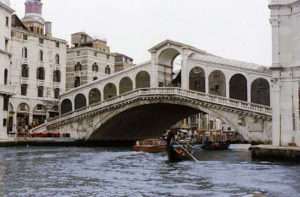
Ponde di Rialto, which was the first bridge to cross the Grand Canal, the final version in stone constructed in the late 16th century.
We liked the beautiful stone arch bridges joining the islands to one another — the most famous one being the covered bridge, Ponte di Rialto, the oldest bridge in Venice, which is also one of the very few (two?) bridges that are still lined with stores. It crosses the Grand Canal and it was the only bridge to do that until Ponte dell’Academia was obstructed in the mid 1800s.
One day we crossed this Academy Bridge to get to the Peggy Guggenheim museum. I remember an enormous gathering of cats of all sizes and colors at the southern end of the bridge. The bridge was built under Austrian rule in the mid 1800s. The masses of cats to be seen around the bridge is actually a common sight for most of Venice as well as for Italy in general.
Winding our way east, we finally managed to find the museum and we greatly appreciated our visit, even thought there was perhaps, for my taste, too much an accent on abstract art. It seems that even Peggy’s uncle Solomon Guggenheim was not entirely in agreement with the tastes of his niece. There are works by all the greatest painters and sculptors from the early 20th century art
During our wanderings we happened one day to come across a restaurant that we thought looked very interesting. It was the Corte Sconta, a mostly unknown jewel at the time among the Venetian culinary palaces. We reserved for the same evening and we found that fish was the main specialty, the old-fashioned metal sign above the entrance being two curved lobsters, most likely.
The food was delicious and the atmosphere very pleasant. But the funniest thing was how we got to talk to the couple behind me, an American-Italian couple, who spent half the year in Venice and the other half somewhere in the U.S. They were amazed to see foreigners at their beloived Corte Sconta. They asked us how us how on earth we knew about this restaurant. They said that we must never mention anything about it to our friends. We told them we had just happened to come across it and we thought it looked interesting. And seafood sounded good. Now, however, the restaurant has become a very ‘in’ place for all sorts of tourists, and you have to reserve a table a long time in advance.
__________________
In 1980 we started on our yearly vacations in Brand, the Austrian Aps, and these mountain hiking vacations were to continue until 2000, when we felt that we did not have the stamina from our younger years and so we gave up on our dear Königer family and friends and went on to more varied traveling. There are four separate chapter about the Austrian Alps 1980 – 2000.
In 1990 we made a long and fascinating trip to Argentina, an interruption in our Brand vacations, mainly to see our dear friend Roberto and his Marta. There is a separate chapter about that trip too.
Continued: Chapter 31 – Our Swedish girls – and other memories
